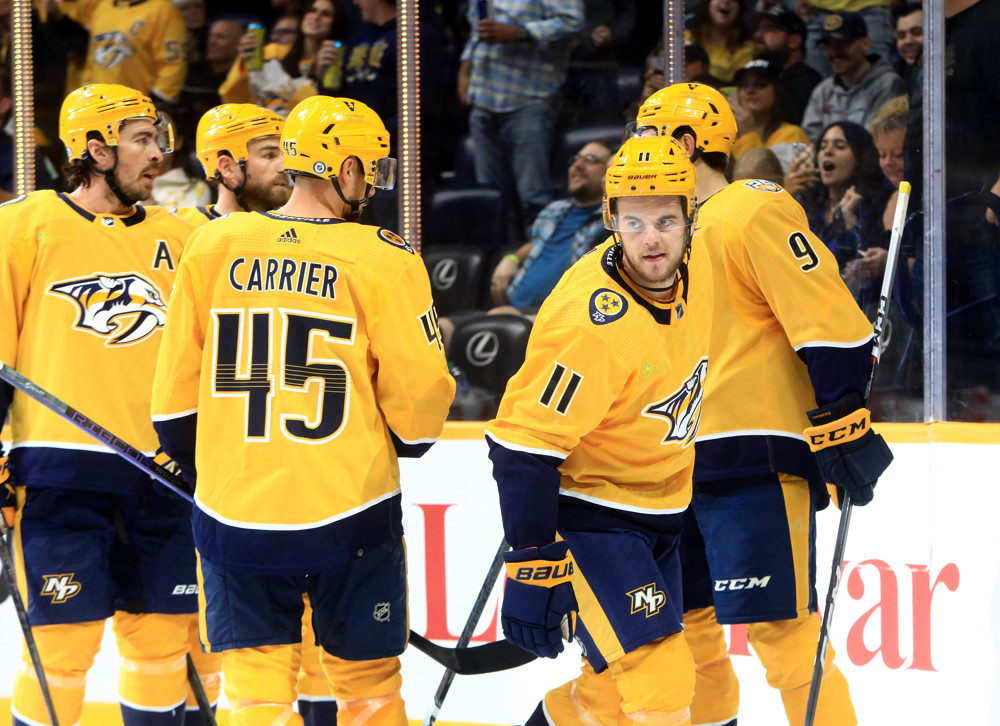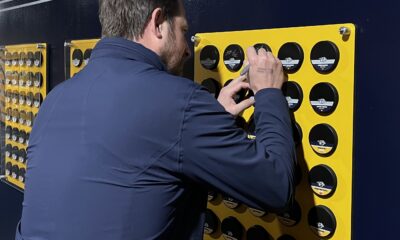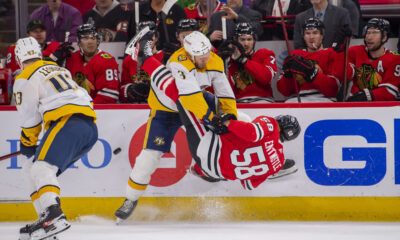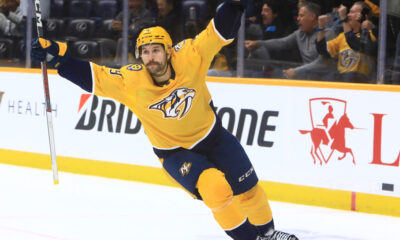For those of you who follow my work on the Locked On Predators podcast, you may be familiar with our weekly “Plus/Minus” segment. If you are, good news! We’re launching a new written-version of it this season here at Penalty Box Radio. (If you’re not familiar with it… then hey! We have a cool new thing to show you here at Penalty Box Radio!)
Each week, we break down the highs and lows of Predators hockey; we assign “plusses” to the players, lines, coaches, concepts, etc. whose stock is trending upwards, and “minuses” to those who have some improvements to work on.
There are certainly no shortage of topics to cover – good and bad – from the first two weeks of the Nashville Predators’ season. So without further ado, let’s jump right in!
Plus: The Top Line
The Predators’ biggest question mark before the season was whether they had enough offensive firepower to play the “run-and-gun” offensive style Andrew Brunette prefers. Through the first two weeks at least, the answer to that has been “yes.” The Predators are currently 10th in the league in scoring and third in shots-per-game.
A big reason for that is the play of the Predators’ first line: Filip Forsberg, Ryan O’Reilly, and Juuso Parssinen. The trio has combined for 12 points through the Preds’ first six games. That point total is actually fairly modest compared to the line’s advanced analytics. Per MoneyPuck, the Forsberg-O’Reilly-Parssinen combo is averaging 5.4 expected goals per 60 minutes played at 5v5, the most in the NHL among all lines who’ve played at least 30 minutes together this season. For those of you not hip to advanced stats, that essentially means the way these three are playing, their line should be accounting for 5 to 6 goals across every three games or so, which is pretty dang good.
It’s a long season, and it’s safe to assume those numbers might drop at least a little bit as the year progresses. But so far, Forsberg, O’Reilly, and Parssinen are doing exactly what they need to be doing as the team’s go-to scoring line.
Minus: Phil Tomasino
It’s not unfair to say Tomasino’s start to the season has been a bit of a letdown in a number of ways. The bevy of veteran departures dating back to the trade deadline seemed to be a prime opportunity for Tomasino, who had 31 points as a 20-year-old rookie just two years ago, to finally cement himself in the Preds’ lineup and show glimpses of becoming the dynamic playmaker the Preds’ trusted he’d become.
At least thus far, however, Tomasino has gone a bit in the other direction. Apart from one assist on the power play, Tomasino just hasn’t been creating chances, and a rash of costly giveaways led to Brunette making him a healthy scratch for the Preds’ past two games. Even before that, Tomasino had been struggling to find consistent minutes; his 9:27 of 5v5 ice time per game is third fewest on the team.
Does this mean we should start the “bust” conversations? Absolutely not. Tomasino still has a lot of upside, and he will undoubtably have chances to get back on the ice and regain his form. But it’s not outrageous to expect more from the 2019 First Round pick.
Plus: The Waiver Wire
You can’t say Barry Trotz isn’t being aggressive in trying to find a few diamonds-in-the-rough. For the second time in the past month, the Preds’ new GM picked up a young forward off waivers, bringing former Blue Jackets’ first-rounder Liam Foudy into the mix. Foudy, 23, is a superb skater with excellent breakaway speed — something we know Brunette and Trotz covet. And although his struggles to develop his game at the NHL-level have been well-documented, it’s also worth noting that multiple Blue Jackets writers said Foudy started taking some big steps forward at the end of last season, which saw him score seven goals in the final two and a half months of the year.
Meanwhile, the Preds’ other waiver pickup, Samuel Fagemo, is already paying dividends. Fagemo scored his first goal with the Preds just a few shifts into his debut game on Saturday. He also logged 4:00 of power play time, proving Brunette isn’t shy about using his new forward in key offensive situations.
Minus: The Penalty Kill
Remember last year when the penalty kill was the one big thing the Preds consistently did well? It’s been a different story this year. The Preds have only killed off 66.7% of their penalties this season, the third-worst penalty kill in the NHL so far. They’ve also allowed multiple power play goals in three of their six games this year, and have only gone two games without allowing a power play goal at all.
The Predators have allowed the second most shots while shorthanded this season, meaning the Preds’ early PK struggles are probably more than just falling victim to a few good shots. The PK units will need to tighten up a bit to limit the amount of quality shots that get through to Juuse Saros. The Preds did manage to kill both power play chances against the Sharks on Saturday, the first time they were a perfect 100% in a game since the Seattle shutout, so perhaps that’s a sign things are moving in the right direction.
Plus: Equipment Manager Assists
You know something cool has happened when some dude wearing joggers and a windbreaker is the first person your team mobs after a clutch goal.
On Saturday, that “some dude” was Predators’ equipment manager Pete Rogers, who played a big role in Luke Evangelista’s third period goal. Evangelista had snapped his stick in the defensive zone moments prior. By the time Evangelista got to the bench, Rogers had a new stick ready to go, giving Evangelista enough time to jump into the play and score the goal. That earned Rogers a lot of love from the Preds on the bench, as well as some national kudos from P.K. Subban and Pat McAfee for the “equipment manager assist.”
Minus: De-Centralizing the Draft
This week, Elliotte Friedman and Chris Johnston reported the league is considering “de-centralizing” the NHL Draft. Basically, this would make the NHL Draft looks similar to the way the NBA and NFL do things, where teams make their picks from a “war room” back at the team facilities, while a select number of prospects are invited to the draft city to attend in person.
This may certainly make more sense logistically, but it would also rob hockey fans of an overall fun environment. There’s something beautifully chaotic about getting the big whigs from every NHL team together in one building every year. It’s fun watching some random Blues executive walking over to talk with some random Coyotes executive and speculating whether those are just two friends saying hi or the inner-workings of some massive trade. It’s fun seeing an 18-year-old kid drafted in the seventh round meander down 40 flights of stairs to collect his first NHL jersey with his family proudly snapping pictures on their phone. It’s fun hearing whispers of a prominent general manager going absolutely HAM on the rooftop of a Nashville Honky Tonk the night before the draft.
The same things that make the NHL Draft unique from any other league are the same things that make it a special experience. De-centralizing the draft would remove just a little bit of that experience from fans, the media, the draftees, and even the teams.
Plus, we wouldn’t have moments like this anymore…












